Land Use and Development
New Housing Development Heads Into Second Phase
Published
2 years agoon
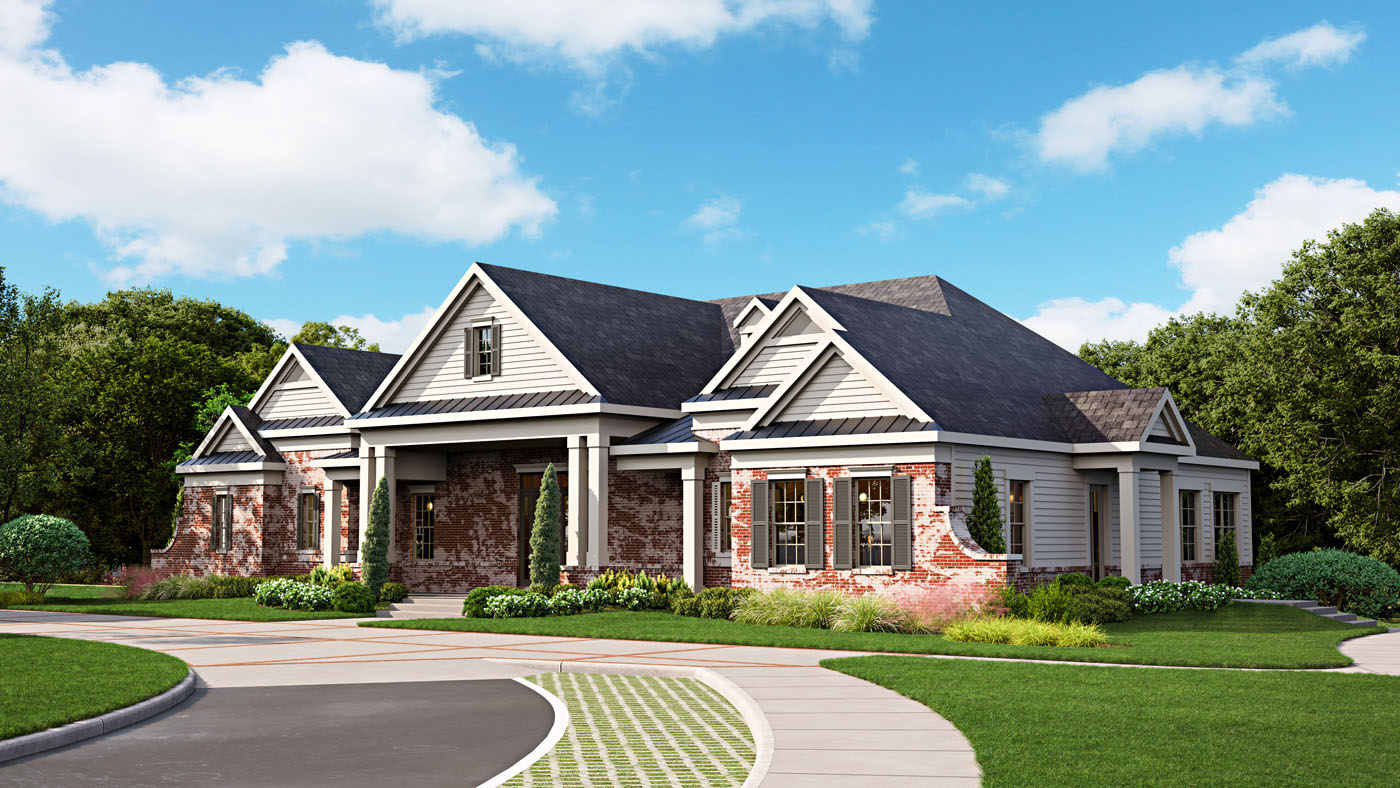
Waterside offers a variety of options for families, seniors and everyone else.
With residential real estate being on a bit of a rollercoaster ride now, a new cluster of housing that’s been in the works for a few years has recently entered into its second phase of development. East Jones Bridge River Holdings which includes The Providence Group of Georgia is the partnership behind Waterside in Peachtree Corners. Originally the project was planned as a 55+ community. Around the time the COVID pandemic broke out, leadership decided to seek an exemption on several of the home types to allow for a broader range of ownership, according to Lisa Murphy, vice president of sales, marketing and strategy.
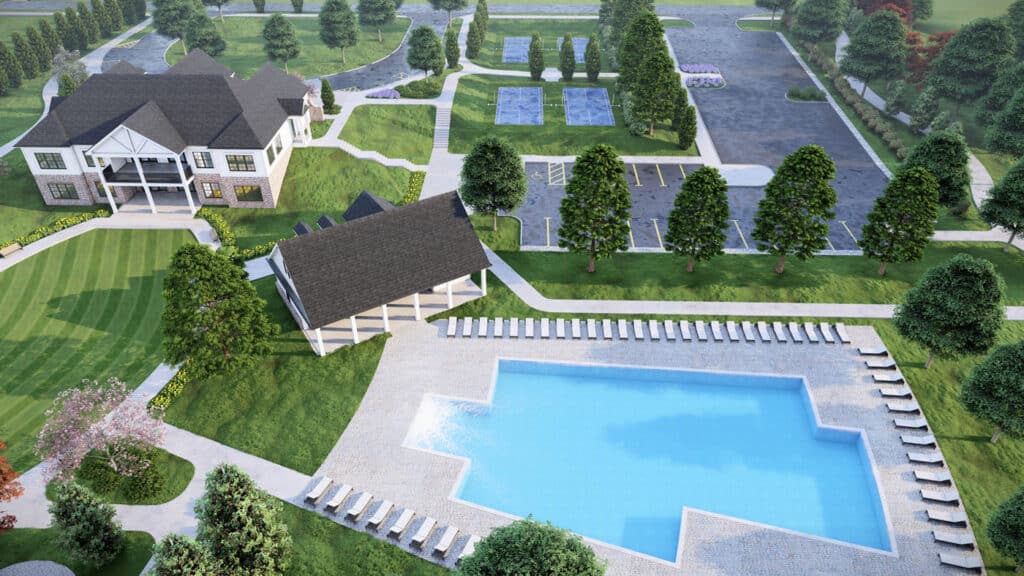
“All of the products stayed the same after that decision. So they still have a master [bedroom] on the main [floor] and we also have townhome products with options for elevators,” she said. ”It is a good community for multi-generational families – a young professional may live in a townhome, his/her parents might live in a single-family home and the grandparent may live in a condo.”
Murphy explained that after the plans were in place for the overall design, look and feel of the properties, the intention was to keep the master plan with all the amenities staying the same. It’s still a gated, master-planned community situated along the shores of the Chattahoochee River with the goal of “aging in place” in mind.
According to Waterside literature, there’s an abundance of both passive and active amenities for a high quality, low-maintenance lifestyle. It’s about a mile from The Forum and Town Center at Peachtree Corners. Many of the quality-of-life attractions of the area are nearby.
By the time this article is published, Waterside may be sold out of properties in the first phase. At the time of the interview, Murphy said there were about nine single family houses still available.
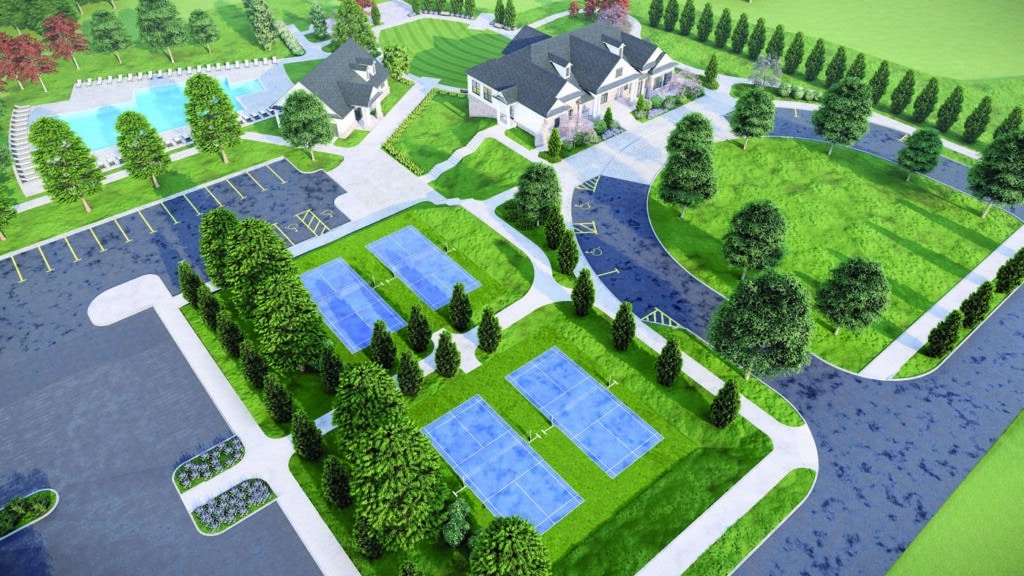
Phase Two Underway
The models for the next phase of development are ready for viewing. Similar to the first part, Phase Two will also include:
Single-family detached cottages with open concept designs, 3-4 bedrooms, owner’s suites on the main level and a private side courtyard.
Single-family three-story detached cottages with four bedrooms, a media room and an optional elevator.
Two-story front entry townhomes with a 2-car garage, 3 bedrooms and an elevator option.
Three-story rear entry townhomes with a 2-car garage, up to four bedrooms and an elevator option.
Condos featuring one bedroom, two bedrooms or three bedrooms with direct access (no shared corridors) and a private garage.
The different types of townhomes have proven to be a hit, said Murphy.
“We have a three-story townhome where one of the plans has an elevator and one of the plans has this really neat outdoor living space. So on the main floor when you walk in you have this big covered outdoor living area as you go up to the front door and then behind that on that main floor is a media room that’s been really popular,” she said.

Murphy added that the two-story townhome also has an elevator option.
“It’s frontloaded and lives like a house,” she said. “It has also been quite popular because it feels like a single-family home. You have a yard in the back. People have enjoyed that.”
The newest products are the condos.
“We have three different floor plans that offer one level living on the bottom level. It’s a one-bedroom condo with a one-car garage,” said Murphy. “This product was designed for typography because if you look at it, the backside has double sided architecture so the back and the front both have full architecture. If you enter from the back, you pull into the garage which is on the bottom floor. If you go around to the other side of the building, you’ll see two stories.”
The look as well as the property “lives” is important, said Murphy. With so many homeowners looking for smaller residences, they still want quality.
“That’s why we say people want to downsize but not downgrade,” said Murphy adding that they consider the properties “shiny and tiny.”
“Compared to the big house that they’re moving out of, they don’t want to give up the finishes and all the things that they’ve gotten used to. So these houses are very well appointed just like a 10,000 square foot house might be in the Peachtree Corners area, but they’re just smaller,” she said.
But don’t think a smaller footprint means squeezing into a little box, she added.
“Our smallest unit is the one-bedroom at 1,564 square feet of living space. And that doesn’t include the outdoor covered spaces. For a one-bedroom that’s big,” Murphy said. “The largest condo is three bedrooms at 2,520 square feet. All the rooms are big and spacious. It will fit big furniture and owner suites are very luxurious with soaking tubs, big showers, big closets and lots of lots of living area.”
Now that the models open, people are encouraged to see for themselves.
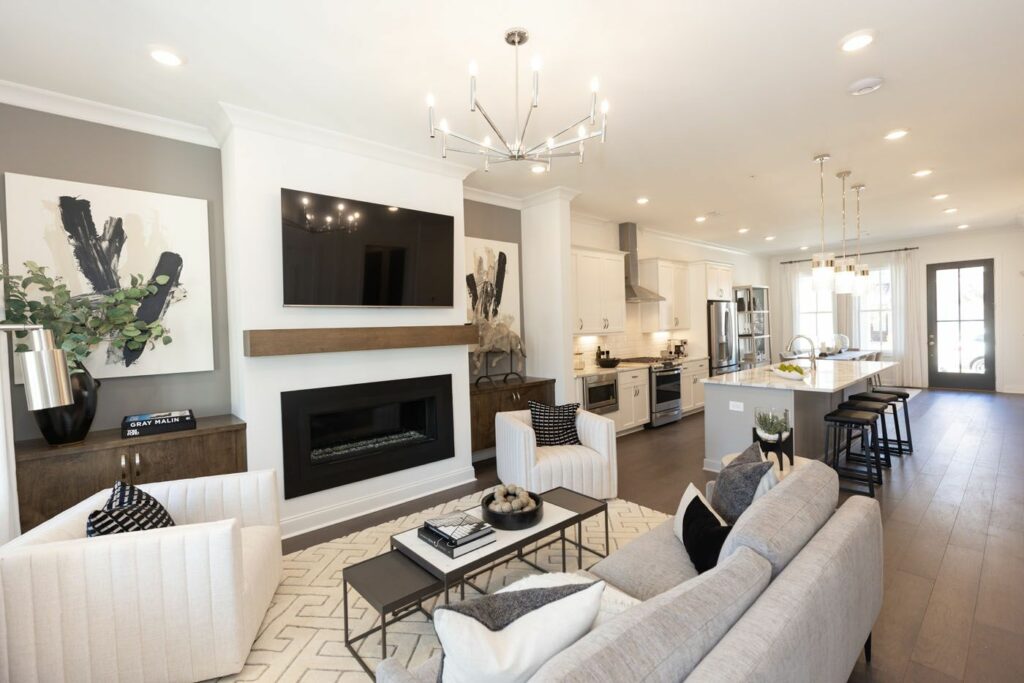
Several Options For Senior Living
One thing that isn’t available yet is the options for senior living facilities.
“Our active adult component will come into play in phase three,” said Murphy. “The way the property is zoned, we have the ability to do memory care, active memory care, assisted living and independent living. All of which would be for rental units.”
The designs for that phase haven’t been finalized and the developers are looking for input from residents before making anything permanent.
“It could be all three of those uses, or it could end up being only independent living,” she said. “We haven’t fully flushed out what percentages of that section are going to be.”
There isn’t a timeline for when that phase will begin.
“Hopefully by the time we’re finalizing that we will have enough owners in the community that we can get some feedback on what they are thinking and what they would like to see here in terms of what their needs are. We’d also have a better read on the overall market and what are the needs of the area at that time, because it’s shifting all the time.”
As a best guess, Murphy said that won’t be in the works for at least another year or maybe 18 months down the road.
But what will be on the horizon is walking trails and the clubhouse.
“Our clubhouse is being completed now. It’s probably going to be finished sometime early fall, but it’s gorgeous. It’s got a beautiful gathering room. It has some meeting rooms. It’s got a card room with a caterer’s kitchen. On the lower level it’s got a couple of massage rooms, an aerobic room and a fully appointed fitness center. There’s also a coffee bar area for people wanting to gather,” said Murphy.
Additionally, there are huge event lawns within the community.
“One of those is already in place in front of the clubhouse,” she said. “We have a very large pool with a pool house. And then we have decks and pavilions built into the landscape that overlook the river and the fire pits. We have a little bar area that’s under a covered pavilion that’s perfect for a cocktail along the river.”
Waterside sales office information
4415 E Jones Bridge Road
Peachtree Corners
(470) 514-6999
Related
Arlinda Smith Broady is part of the Boomerang Generation of Blacks that moved back to the South after their ancestors moved North. With approximately three decades of journalism experience (she doesn't look it), she's worked in tiny, minority-based newsrooms to major metropolitans. At every endeavor she brings professionalism, passion, pluck, and the desire to spread the news to the people.

Land Use and Development
Peachtree Corners City Leaders Engage Residents on Land Use Development
Published
8 months agoon
October 14, 2024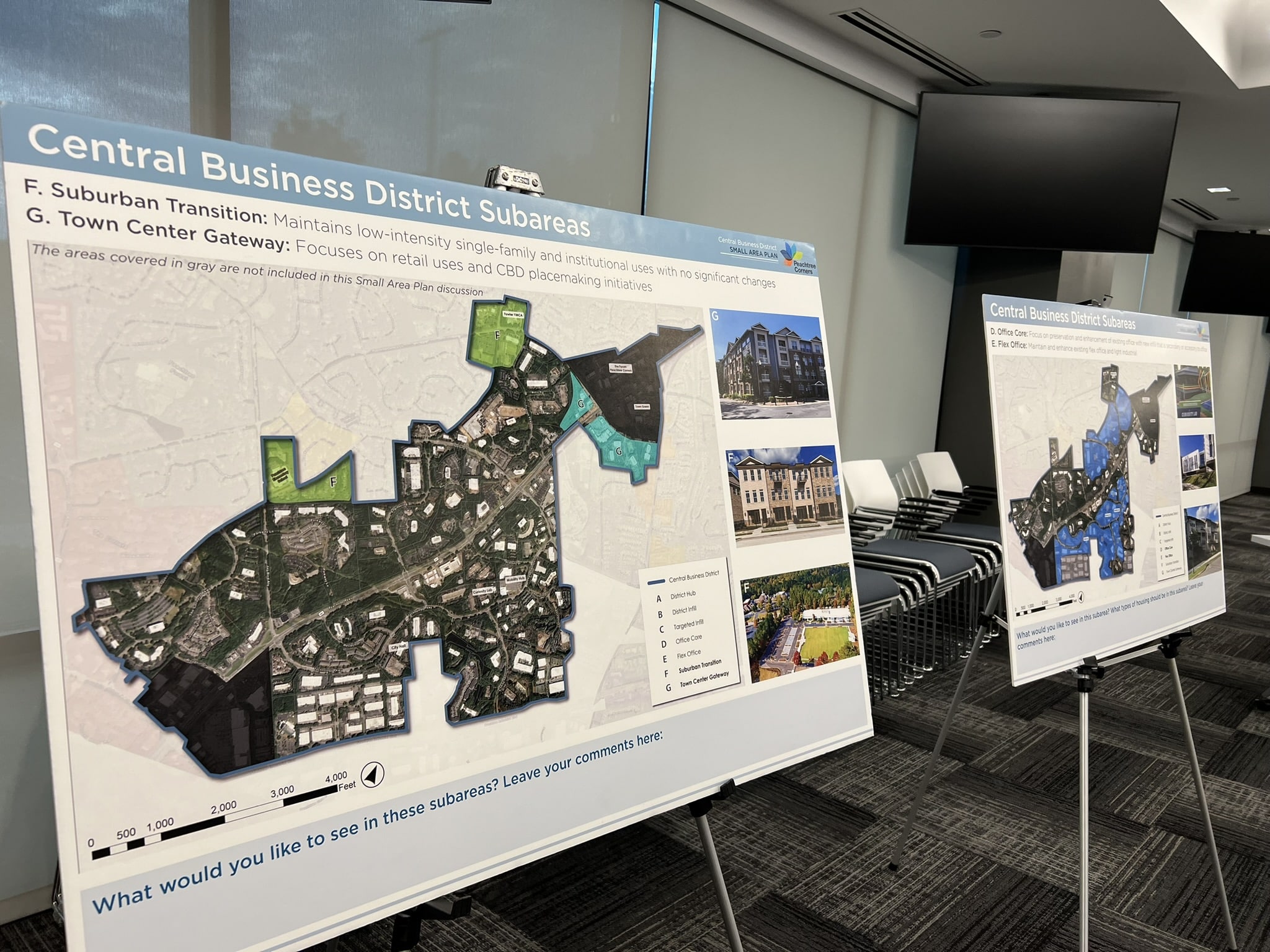
Even though the moratorium on land use development applications within the city of Peachtree Corners expires on November 3, it will be next year before investors have plans before the city council.
“Any rezoning requests must first have a pre-application meeting, which means it wouldn’t be on the planning schedule for at least a month. That means the planning commission could look at it in December, and it wouldn’t come before city council until January at the earliest,” said Community Development Director Shaun Adams.
Adams sat down with publisher Rico Figliolini for a Peachtree Corners Life podcast prior to the city’s October 3 open house where residents and stakeholders were invited to give input on land use issues within the city.
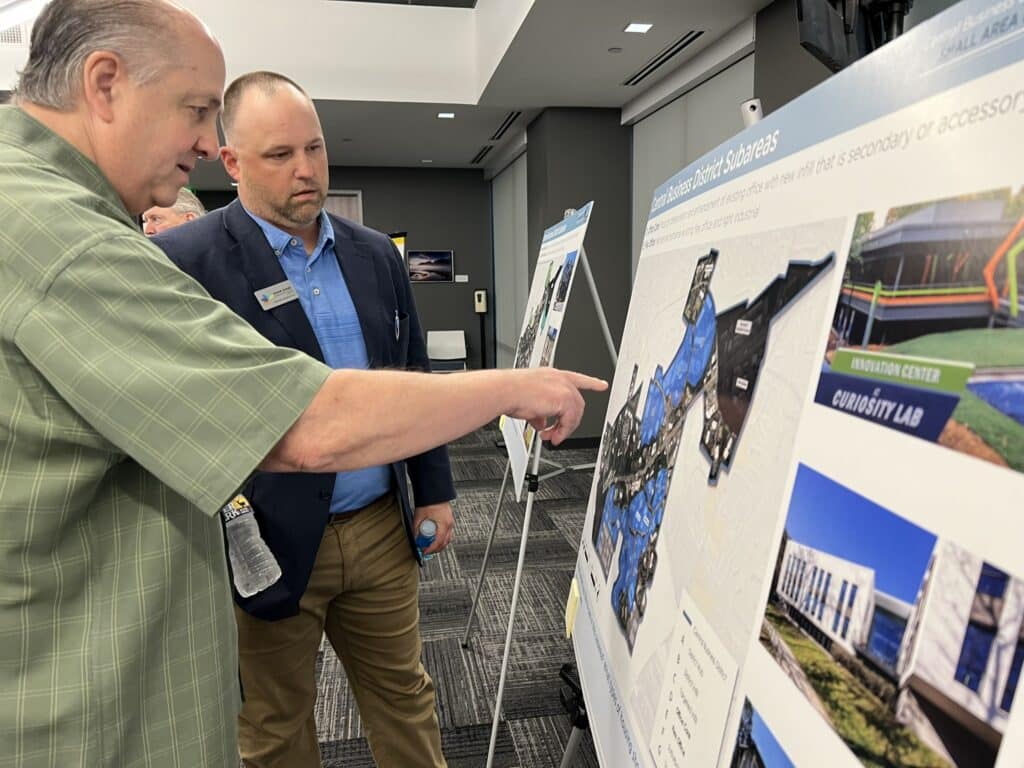
Area plans
“One of the reasons why we’re not extending the moratorium is because I think there’s enough of an idea of the kind of vision for the area that no one’s going to come in at this point in time with a proposal that isn’t trying to align itself with the updated plan,” he said, adding that this is a kind of refresh of plans that were adopted about two years ago.
“The point of this open house was to say, ‘Hey, here are the highlights of what most of you said 18 months to two years ago, what’s changed?’” said Adams.
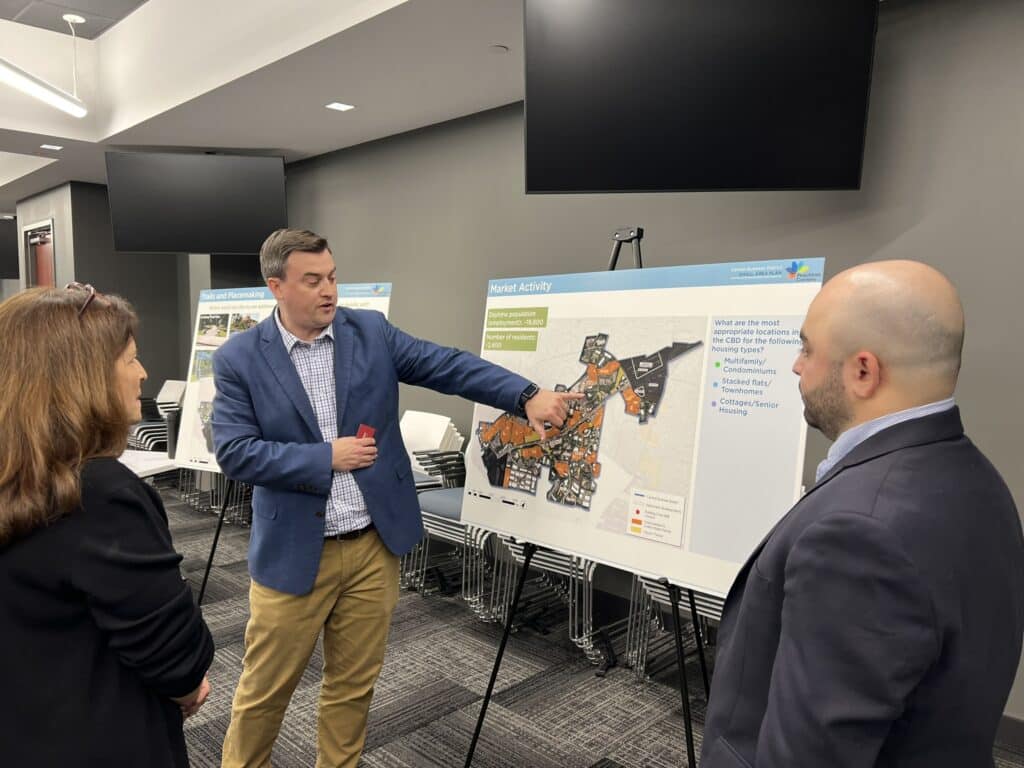
With Technology Park and surrounding office parks making up the city’s economic engine, plans need to focus on how to stabilize them, enhance them and ensure that the amenities they need remain in place.
“We had a chance to look at it in a small area plan — an asset inventory and condition assessment,” said Adams. “We literally put eyes on every commercial building in the central business district. We took a look at the data … and kind of applied the grade to them to help understand what areas within our office parks are performing better … and where things are a little dilapidated.”
Maintaining citywide perks
“As I’ve heard it, we’re the second largest municipality in the state with a zero millage rate,” Adams continued. “One of the ways we’re able to do that is because we have this great balance between jobs, or daytime population if you will, and our residences or nighttime population. And so, maintaining that balance as best as we can is definitely kind of at the forefront of our minds.”

The ability to sustain a desired quality of life and robust economic growth all without levying property taxes is a point of pride for Peachtree Corners. Maintaining that distinction is part of the careful planning process.
“From an economic development standpoint, one of the things I’ve always looked at is having the jobs is great, but one of the things we need, to be able to support the businesses in our community, is the ability for their work force to live near their job,” said Adams.
“That’s where the housing stock comes in. The right mix of housing stock that supports not only our current residents but also those that are coming to the area by virtue of the businesses that we’re attracting. Because, if we can’t support their workforce or their workforce can’t stay close to work, then ultimately, the business is going to follow the workforce.”
The central business district
The city’s central business district can be defined as Holcomb Bridge Road up State Route 141 to The Forum and Town Center. Within that area, Tech Park, Spalding Triangle, Corners Parkway — those areas up and around SR 141 — are the main focus of the study and moratorium.
“At about four months in, one of the biggest things that we’ve done is an asset inventory. We really took a look at our underutilized spaces, vacancy rates, condition assessments, what approvals or redevelopments have occurred so far, but maybe haven’t come out of the ground yet,” said Adams.
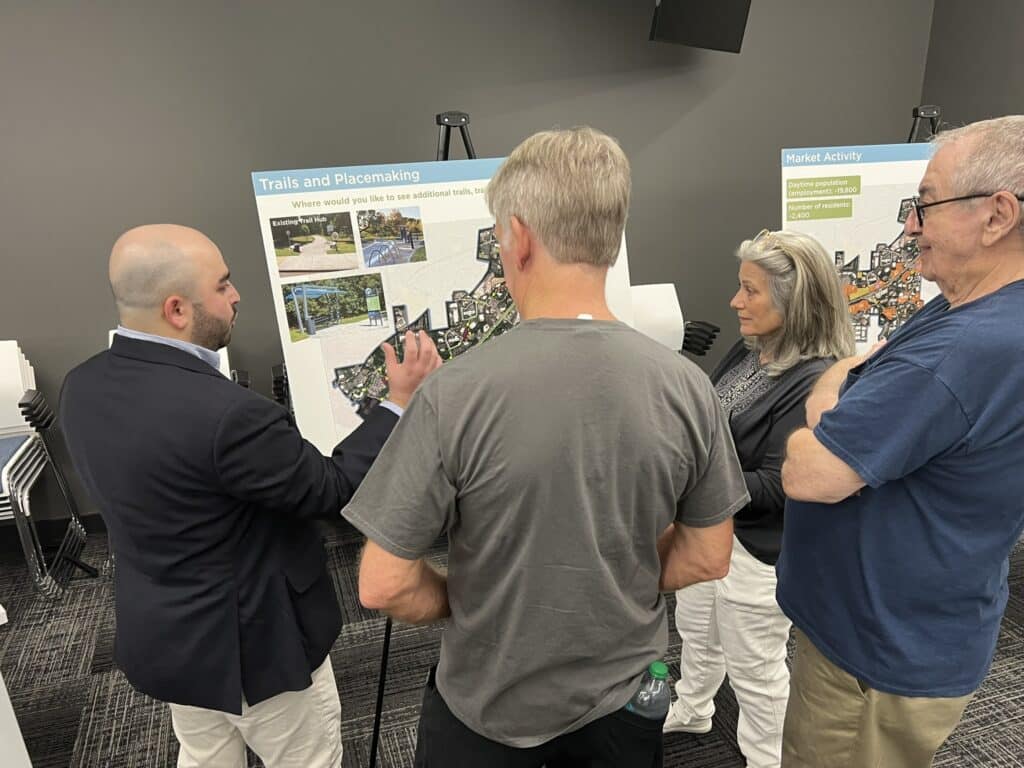
He added that conservation and maintaining the city’s tree canopy and green spaces are also a big part of the study — including trails.
“We have some [trails] that are already in design and underway or built, but we have others proposed,” he said. “But those proposals are largely based off of where we kind of have a path of least resistance through properties or easements. As redevelopments come into play, there could be opportunities to maybe realign the trail so it makes more sense based on what’s coming down in the future.”
“If things go in the right direction, or the timing is right, the city can connect key stretches of trail through Tech Park that could allow people to run from their office to The Forum or wherever to their home,” he added.
Creativity within available space
From a development standpoint, the city is looking to attract diverse businesses, whether it’s suppliers to some of the existing companies, such as Intuitive Surgical, or also life sciences and similar industries.
“We’re certainly wanting to try to attract them in where we can, using Curiosity Lab and what we do there to maintain that technology focus of Tech Park,” said Adams. “We’re hoping that by doing more and maybe even — looking at opportunities for the testing that goes on at Curiosity Lab — thinking about it on a larger scale than a test track or a facility … [we can expand] our opportunities to partner with businesses within the area to test certain technologies, maybe on their property or around it, that type of thing.”
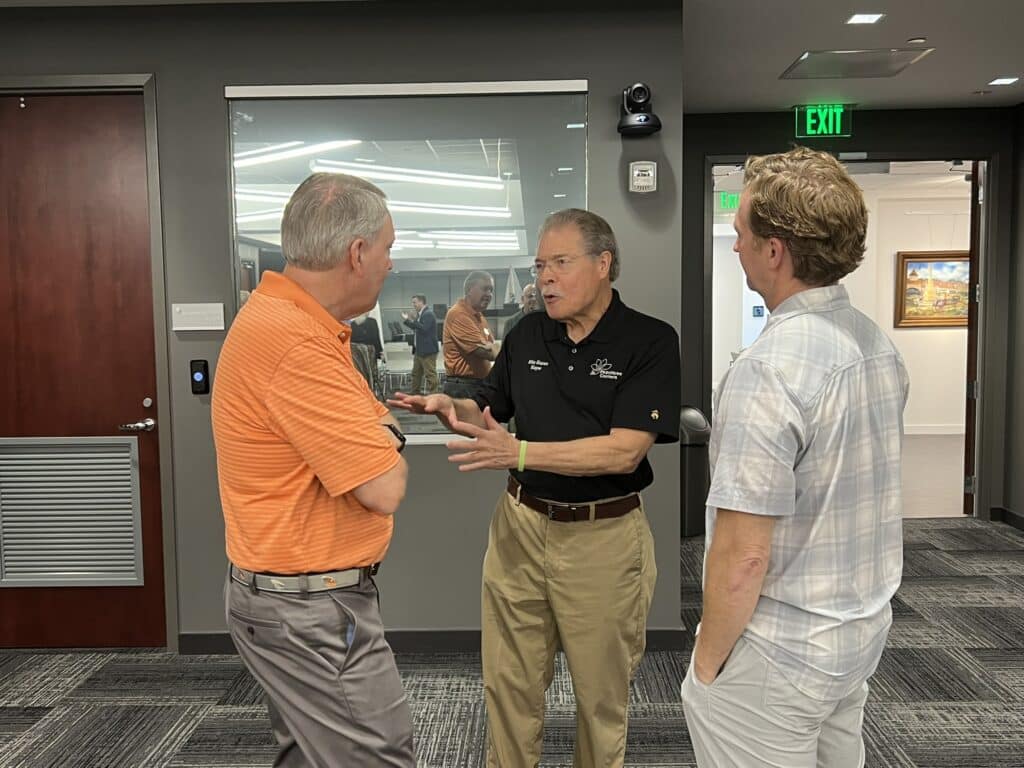
With Georgia Tech already teaching some classes in Peachtree Corners, there may be opportunities to bring in an institution that supports local businesses or [bring in] suppliers or accessory users to some of the larger corporations that are already in the area.
Mixed-use development
Similarly, Adams said that the small area plan itself is going to be focused on “kind of the nodes and maybe what goes [in], generally speaking.”
“We’ve identified gaps in our code to be able to achieve what we’re trying to do,” he added.
While Gwinnett County has a traditional neighborhood development zoning district where you can have a mix of townhomes to three different lot size, single-family detached homes under one development, Peachtree Corners doesn’t have a code that allows for different types of housing under one subdivision or development.
“We’re a redevelopment city,” Adams said. “We don’t have big swaths of green space to be able to develop estate-sized subdivisions on anymore. So how can we be creative about the space that we have, the infill opportunities we have, to put developments on there that attract the buyers that we need?”
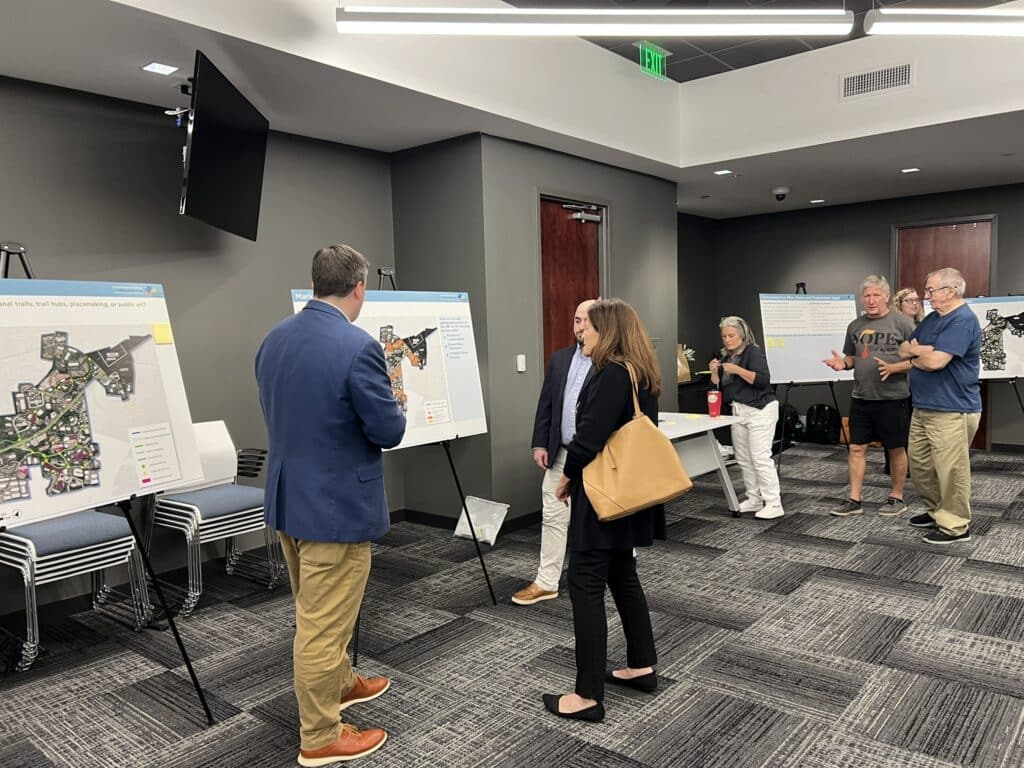
Seniors, families and young professionals
One thing the city acknowledges is that there has been a cry for more housing for seniors.
“We’ve heard them say, ‘Look, I want empty-nester-style housing, but I still want to own it,’” said Adams. “So, we want to find that product type for you.”
A similar demand for property types for young professionals and families also exists.
But creating those opportunities at an attainable price point is a conundrum, with certain fixed costs in construction that can’t be controlled.
“One way you can control it is by being creative about setbacks, lot sizes, density and things of that nature,” said Adams. “[We’re] looking for opportunities to allow for that, so we don’t just have a bunch of townhomes coming in.”
For more on land use in Peachtree Corners, visit peachtreecornersga.gov/1406/current-land-use-cases.
Photo credit: Rico Figliolini
Related
Land Use and Development
Navigating Land Use Changes, Business Growth, and Community Engagement in Peachtree Corners [Podcast]
Published
8 months agoon
September 25, 2024
Exploring Land Use with Shaun Adams
Land use changes, business growth, and community engagement shape Peachtree Corners’ future. From revitalizing office spaces to innovative mixed-use developments, the city is working to attract investments and meet the needs of its residents.
Peachtree Corners Life’s host Rico Figliolini is joined by Shaun Adams, Community Development Director, to discuss how the city adapts to new trends, assesses vacancy rates, and gathers public input to guide its growth. Learn about the city’s plans, including focusing on office renovations and diverse housing options, and how the community can get involved in the upcoming public meeting on October 3rd.
Resources:
Peachtree Corners Website: https://www.peachtreecornersga.gov/
Community Development: https://www.peachtreecornersga.gov/190/Community-Development
October 3rd Community Engagement Meeting: https://www.peachtreecornersga.gov/CivicAlerts.aspx?AID=210
Timestamp:
00:00:00 – Peachtree Corners Land Use Moratorium
00:01:58 – Revitalizing the Central Business District
00:04:53 – Public Engagement Meeting
00:07:06 – Insights from Asset Inventory and Changing Business Trends
00:11:11 – Improving Office Amenities and Competitiveness in Tech Park
00:14:03 – Reinvestment in Aging Office Buildings
00:16:15 – Evolving Uses in Office and Mixed-Use Developments
00:19:51 – Attracting Diverse Businesses
00:24:00 – Exploring Mixed-Use and Diverse Housing Options
00:27:39 – Mixed-Use Development
00:29:42 – Efficient Residential Density Options
00:33:17 – Trail Connection Around Technology Park Lake
00:40:41 – Evolving City Management through Conferences and Collaboration
00:43:00 – Accessing City Development Information
Podcast Transcript
00:00:00 – Rico Figliolini
Hi, everyone. This is Rico Figliolini, host of Peachtree Corners Life here in the city of Peachtree Corners, Gwinnett County, Georgia. I’m here with our Community Development Director, Shaun Adams. Hey, Shaun. Thanks for joining us. Before we get started, and we’re going to be discussing the land use moratorium that’s been in effect for almost six months. But before that, I just want to say thank you to EV Remodeling Inc. for being a sponsor, not only of our magazines and our journalism, but these podcasts as well. So you should visit them. They’re a design build firm here in Peachtree Corners. Eli will take care of you. He’s a great guy. The company is called EV Remodeling, and you should go to evremodelinginc.com and visit them. Some great pictures of what he’s done over the past few months. You can browse right through there and then reach out to him. So let’s get right into it. The moratorium is just more than halfway through. It’s going to end November 3rd. And this is a moratorium on residential new application rezonings in a specific area in the central business district. So at some point, there were so many things coming in and so many applications coming in, so many people taking somewhat advantage of wanting to do what they want to do, that the city decided to stop and put a moratorium on new applications to say, well, I think we need to look at this, change a few things maybe, have some public hearings, focus groups, and come back and add to that land use plan, which is, I think, a great thing you all have done. That’s going to end November 3rd, and there’s a public hearing that’s going to be coming up for public comment, I think, Thursday, October 3rd, between 6 and 8 p.m. at City Hall. So we’ll get into that. But I want Shaun, Shaun, if you wouldn’t mind explaining a little bit about why the moratorium briefly was put in place and where you all you know where the city’s at what the timeline has been actually moving forward on that.
00:02:13 – Shaun Adams
Sure thing. So as you indicated you know the central business district just to help people out if you really think from Holcomb Bridge Road up 141 to into the Forum, Town Center. That’s kind of our central business district area. This plan within that is really going to focus on our commercial office portion of it. So Tech Park, Spalding Triangle, Corners Parkway, those areas up and around 141. And so about four months in and what we’ve kind of done so far, one of the biggest things that we’ve done is an asset inventory. We really took a look at our underutilized spaces, vacancy rates, condition assessments, what approvals or redevelopments have occurred so far, but maybe haven’t come out of the ground yet. Looked at our existing proposed trails. You know, we have a trail study. We have some that are already in design and underway or built but we have others proposed but those proposals are largely based off of where we kind of have a path of least resistance through properties or easements but as redevelopments come into play there could be opportunities to maybe realign the trail so it makes more sense based off what’s coming down in the future. And so the first couple months took a lot of time taking a look at that and understanding where we are. We looked at about 100 commercial office buildings. So that was good feedback to use for now and in the future. August, September, we had a couple of focus groups. One of the first ones we did was with a combination of some of our existing board members from Planning Commission and our two authorities, our Downtown Development Authority and our Redevelopment Authority. And what’s great about their feedback is not only do they have a level of industry expertise that runs the gambit from real estate to finance to development to engineering, but they’re all residents who care about seeing how our city moves forward. And so that was a good group. We had about 18 in total there, which for a focus group is a good size. Our consultants kind of ran that meeting. We showed them our map of the asset inventory that we did, kind of used that as a jumping off point. And then we turned around a few weeks later and did the same with some of our brokers and office owners in the area that do a lot of business here to help kind of learn what are they hearing, whether they’re a broker who’s representing a building for sale or they’re representing tenants looking to lease up. And understanding when they’re showing buildings with their tenants, why are they choosing here versus why are they going to Alpharetta or somewhere else? What’s missing? And so we got a lot of good feedback as a part of that focus group. And as you’ve mentioned, public engagement meeting, October 3rd, we’re going to take kind of what we have to date, bring that to them. It will be in council chambers from 6 to 8 p.m. It’s an open house style. And so just kind of help everybody out with that. We will have representatives check them in, kind of give them a one page, if you will, of what we have, what they’re going to see. Using council chambers will be great because we have the TVs down the sides where we’ll have that map up. So no matter where they are in the room, they can see the map. We’ll probably have four to six stations, each one kind of representing a different subsection, if you will, of the central business district. And we’ll have both staff and consultant representation at each of those so that people can come in, they can ask questions about what they’re seeing. We’ll have boards there. And if you remember during the comp plan update process about two years ago, or a little less than two years ago, people were able to put dots in, provide feedback based off a certain question. So one of the benefits of Kimley Horn being our consultant on the small area plan is they were also the consultants on the comp plan. So they have all of that data that the public gave previously. So one of the things we wanted to do is as a refresher as well, is say, here’s what you said 18 to 24 months ago as it relates to the central business district. Here is what the business community has said through our broker owner, Finkers groups or other Finkers groups we did this time. What do you see? What has changed for you in the last 18 to 24 months based off of the feedback provided? Or for those of you who weren’t either in the community at that time or for whatever reason weren’t able to be a part of those sessions, your input can come in as well. So this is building upon the input that we had and helping understand what’s changed. And by having that data there, I think it’s good for the community to see, oh yeah, this is what we thought back then. I agree with that still, or you know what, based off of, you know, XYZ, I think it should be something different and here’s my input. And so we can bring all that together. And then with that, we have a good six week time period before it would be set to go before planning commission in November and council in December. Both of those times, of course, will be public hearings where the community will be able to provide additional input as you would in a typical process.
00:07:19 – Rico Figliolini
Alright. So I have a couple of questions that pop up just because of the discussion here. Was there any surprises you found when your group did the asset inventory of 100 buildings? Because we all have an impression of what we think is going on. But were there any surprises that you found while you were doing that?
00:08:04 – Shaun Adams
You know, there’s quite a few things. That and the vacancy aspect of course. The trick is we’re using CoStar, which may not always be accurate, but kind of seeing the number of buildings that kind of blended together in terms of where we have needs for activation of underutilized space instead of it being just pockets here and there. It’s kind of Corner’s Parkway area, actually. You think about some of the properties over there, there’s a lot of small parking, building. So it’s kind of nice to see kind of how these nodes may have formed throughout that process. And you know another thing is how few properties it would take to connect key pieces of our trail and where some of our hubs are naturally already starting to take shape to say, okay, if a couple of things go in the right direction or we can time these right, then we can connect key stretches of trail through Tech Park that could allow people to run from office to the Forum or wherever to their home.
00:09:06 – Rico Figliolini
Did you find, as you were doing those asset inventories, I don’t know how detailed it was, but types of businesses in there, did you all notice any shift or difference over the, I don’t know even how you would quantify that necessarily without going back a few years, but seeing the turnover maybe would be, is probably the better question over the last five, six years, changes in the type of business in that inventory.
00:09:34 – Shaun Adams
So, I mean, one of the things we are seeing and matter of fact, I mean, it would jump ahead, but we had a recent rezoning, resolving a split zoning, and probably seen a couple of tax amendments for uses like fitness studios come in. But what we are seeing is that flex office is stronger than a lot of traditional office right now. So you have a lot of smaller businesses who need, they don’t need a whole lot of admin office space, you know, a couple of thousands per feet, but they might need a space to house excess inventory or supplies because they’re a service-oriented business that provides their service offsite, mechanical contractors, commercial janitor services, things like that. And an office institutional zoning doesn’t do well with that, but we’re seeing flex office spaces like a lot of our one-story buildings are, where they have that kind of mix of office and warehousing. That’s coming in more, it’s coming in stronger. And so making sure that our code aligns with that is something. And we’ve also heard from the brokers and owners that these are some of the uses that are coming in.
00:10:46 – Rico Figliolini
To go into the brokers and owners, or maybe just the brokers for the time being, or a mix of both, what are you hearing from them that we lack? Let’s start there first, from let’s say Alpharetta or Roswell. Alpharetta is like one of the biggest tech hubs north of Atlanta. Probably 700 companies, if that’s still a good number, there are startups and tech companies. Obviously, that’s a competitive space, right? A competition or rival for us, if you will. So what are we lacking? Have you heard anything specific?
00:11:22 – Shaun Adams
Some of what I’ve heard, I mean, I think you might have seen too in papers of race to quality. You’ve heard that a little bit. And so with a lot of our office stock, it was built in the eighties and those that have kind of redeveloped over time or, you know, reinvested into the office over time, they’re positioned even better, But, you know, having more of that activation and amenitizing of the surrounding. So as we talked earlier about green space, trail connectivity, having some retail or supporting service base in the studio or something like that, where they can work out during lunch and not have to go up to Town Center or somewhere else, but having something kind of central to Tech Park that they can easily get to, or if they want to walk the trail to get to it on lunch, just to clear their head for an hour. Having that is something that, you know, we’re hearing we could use and put us in better competition. But the other part of it is to some of the buildings and seeing them. Part of what we did is reassess the property by looking at the parking, the signs, the landscaping, and the building. Because we can understand based off of how each owner is investing in that building, you know, are they in ramp up mode of trying to pull tenants in or are they in maintenance mode? And being able to understand where that building is in its real estate life cycle or that property is can kind of help us better plan for how can we preserve it and enhance it and stabilize it for the long term.
00:13:03 – Rico Figliolini
So are you seeing, I’m thinking Intuitive Robotics, right? They’re moving along, their construction is being done. I think the parking deck is, I don’t know if it’s complete, but everything’s moving along there, for example. Modern, new looking. Some of the buildings are moving to renovate, right? At the outside of it, new monument signs also I’ve noticed as I drive through Tech Park and some of the other areas but so is that something that you’re seeing too like an outward visible change to the buildings? Because driving to work you know a lot of people were working remote, some people, a lot of people are working remote. A bunch of people are working. It’s hybrid also, and you want to enjoy where you’re working. Some of these old buildings are really old buildings, like you said, 80s and 70s. You feel like you’re going back in time almost in some of these buildings. Are you seeing a reinvestment, a larger reinvestment than you all thought coming in? Because that’s difficult. They’re not rezoning or filing an SUP or something. So they have to file a permit to do certain things. But are you seeing things more than you thought?
00:14:20 – Shaun Adams
We’re seeing some in various places. Again, I think the flex office building stock is doing it more and more. And so those office buildings that are one story, roll up doors in the back, they’re going well, they’re leasing up. Some of the mid-rise office, it’s really honestly a mix. Couple of corporate locations have come in recently, which has been good and has taken up some space in those areas. And that’s helpful. I would say it’s largely stagnant, but part of that right now was what the cost is to bring a building up. They’re having to get, some of what we’ve heard from brokers is, hey, if we’ve got to get a building and spend 100 plus a foot on it to get it to 200 a foot then it’s hard to get the rents to justify that cost and that’s kind of what puts it in maintenance mode. And so part of what we asked was okay, how can we amenitize around you, bring something in to make it easier to invest into that property so that you can justify the rents. Because if you have the amenities, then you can probably get the rents as well. And so that’s part of what we’re hoping to identify out of this plan is where we can, you know, make some of those adjustments. I’m also hoping that rate cuts make it easier for them to want to invest. So I feel like every other week we hear companies are bringing people back to the office. You know, remote work is here to stay. And I think until that pendulum kind of settles down in the middle, it’s just going to be a state of flux.
00:15:57 – Rico Figliolini
Okay. Yeah, the rates, I mean, half point drop. Who knows if next year will be another half point drop next quarter or the quarter after. But yeah. And I think the market, I mean, from what I see anyway, from what I’m hearing, right, the market has accepted it already. I think they’ve already worked it in, but who’s an economist? The economists don’t even know sometimes what’s going on. It’s like the stock market. People say, well, drop 500 points. Why did it? It’s like no particular reason. People are covering shorts maybe you know it’s just like or whatever the new use is. I know that there’s, you were talking about like fitness places and stuff. Are you, what type of new uses are you seeing that the city has to sort of work into the into the regulations that don’t exist like that’s not enumerated out there? Are they specific?
00:16:55 – Shaun Adams
So using fitness studio as an example we have health and fitness centers in our code currently and they’re in C2 and that typically is your LA Fitnesses, things of that nature. And so when you think about Stretch Lab and Cryotherapy and Alloy Personal Training and some of those ones that you see in the Forum, they can go in under that already because it’s a C2 or it’s a mixed use development. But C2 uses are allowed in there. What we are finding is some of our buildings that are office buildings, how they’re zoned O&I or zoned M1, those uses aren’t contemplated because they tend to be retail heavy. But on a smaller scale, 4,000 square foot fitness studio or CrossFit box or something like that may be a good amenity to put in the main floor of an office building to support the tenants out of there. But our code wasn’t allowing for it. So as we identify some of those uses, we’re trying to make sure that, okay, we’re not opening a pandora’s box of allowing them to go somewhere where they don’t make sense. But as long as they’re an accessory and supporting to the overall office environment, then we want to allow that. So that’s one great example. And that’s why that one was put in there. The kind of social hobbyist clubs that you’ve seen, you know, we’ve talked a little bit about the car storage, car club. We’ve seen other, I’ve seen golf simulator clubs come in that kind of blend a business club environment, but have that simulator component to it. I’ve seen those in different jurisdictions and just wanting to make sure that if it’s something that fits in an office building as it currently stands and can be, you know, a supporting amenity and draw an attraction to the tenants there, then want to make sure our code, you know, allows for it because that’s only going to help them lease it up.
00:18:44 – Rico Figliolini
Right. I think we, at some point, talked about, I think Brian Johnson and I, at some point, talked about, or at least I brought it up, about use is a larger use, if you will. I’m always thinking that there’s 500 acres there. And like you said before, just because of the nature of the beast, some things evolve, these nodes are created and such. Is there even thought or discussion, have you heard from brokers, on bringing in larger campus-type development into an area? GSU, for example, has several satellite campuses throughout the city. One in Dunwoody, for example. Georgia Tech has done that, I think, or UGA in several ways, places. And that’s just education hubs like that. Has that ever come up? Or even has, because we’re autonomous vehicle and autonomous smart city focused, there’s also pharmaceutical biofabrication companies, those types of companies. You know, just a different, have you heard anything, or has anyone talked about that, like diversifying the type of businesses here in the city?
00:20:04 – Shaun Adams
From a development standpoint, our team is certainly looking out there and trying to attract, whether it’s suppliers to some of our existing companies that are here in the area, the Intuitives of the world, people of that nature, also life sciences, those types of groups, certainly wanting to try to attract them in where we can using Curiosity Lab and what we do there to maintain that technology focus of Tech Park. We don’t want to lose that where we are. So we’re hoping that by doing more and maybe even looking at opportunities for the testing that goes on at Curiosity Lab, thinking about it on a larger scale than a test track or a facility, but where our opportunities to partner with businesses within the area to test certain technologies, maybe on their property or around it, that type of thing. I mean, I’m not in the middle of that every day. That’s more kind of the ag dev side, but I certainly touch it and support it where I can. I haven’t had people kicking tires on it recently from that standpoint, but I think certainly I know Georgia Tech teaches some classes up here already, you know, any opportunity to bring institutional in that supports the businesses around or kind of supplier or accessory users to some of our larger corporations that are here. That’s definitely a focus of our economic development team.
00:21:35 – Rico Figliolini
Okay. Moving away from that a little bit, did the moratorium include changing some regulations with regard to actual development, like the actual building of buildings or the actual renovation of buildings where we have an opportunity if someone comes in for a special use permit or for redevelopment to say, okay, I think we’ve learned something over the last two years. Maybe we want more. If there’s going to be a residential component to something, we want to make sure that, I don’t know, it’s LED certified or it’s individually wired units. I know that’s part of some of the zoning, but is any of that being revisited?
00:22:19 – Shaun Adams
Certainly. I mean, one of the things that, I mean, the small area plan itself is going to be focused on kind of the nodes and maybe what goes there, generally speaking. But what I’ve talked with the consultants about is as we identify gaps in our code to be able to achieve what we’re trying to do. The plan, recommendations for tax amendments in that regard is important as well. And that goes to the regulation just from the building side. I mean, one of the things, you know, I kind of intentionally did with a couple of the development proposals that came through recently was get a little more specific on the elevations and especially elevations that touch or have visibility to public right-of-way to ensure that we can as closely as we can get it to come out of the ground as it looks on paper you know we want to be able to do that because if you’re selling a vision we want that vision to be reality and not you know an alternate you know universe of it kind of thing. So I’ve done that by virtue of conditions where I can, because when you put it in code, right, you might find yourself in an unintended consequence of not having the flexibility. But we are intentional about that. I will say we’ll probably see a couple of new zoning districts come out of this to kind of help bring us up to what the market is really looking for. For example, we have one mixed use development in our code right now, and it’s three uses. It’s 32 plus units an acre. The way the uses are identified is office, residential, and retail. We’ve kind of interpreted public uses such as a trail as a use in previous districts. And that may make sense for a kind of downtown core where you need a ton of residential to support the retail because it’s a retail heavy center like Town Center and the Forum but it may not make sense in Tech Park where you’re activating a utilized space so looking at more of maybe say a commercial mixed use where it stays commercial heavy you’re preserving the office the redevelopment of any retail and or residential that exists is more supporting its accessory or you know and supporting to the commercial property creating an opportunity for that where it might make sense. And then also we don’t have a code that allows for a mix of housing types under one subdivision, if you will, or development. So, for instance, Gwinnett County has a traditional neighborhood development zoning district where you can have a mix of townhomes to three different lot size single family detached home under one development. And, you know, part of what we’re seeing now, we’re clamoring for built-for-equity products. We’re a redevelopment city. We don’t have big swaths of green space to be able to develop estate-sized subdivisions on anymore. So how can we be creative about the space that we have, the infill opportunities we have, to put developments on there that attract the buyers that we need. We need housing for seniors. We’ve heard them say, look, I want empty nester style housing, but I still want to own it. Okay. So we want to find that product type for you. I’ve heard a phrase, first stroller generation recently. So you’ve got young professionals, but then as they get married and they have that first baby to push that first stroller, their thoughts on what their home life is going to be is different than the young professional, and maybe it’s still single or married without kids. And so how do we create those opportunities for them at an attainable price point? And you have certain fixed costs in construction that you can’t control. And so one way you can control it is being creative about setbacks, lot sizes, density, and things of that nature. And so looking for opportunities to allow for that. So we don’t have just a bunch of townhomes either coming in. How can we mix product types into smaller infill developments, getting the density that somebody may need to justify the product or the project while providing a product that the market’s actually looking for.
00:26:32 – Rico Figliolini
Obviously, that makes sense to me. There’s different needs, right? Different age groups have different needs, like you said. And some of them may not want the large land, but they may want. I’ve seen developments like, for example, I think it was Trellith, Georgia. That’s where the big studio is. And some other places similar to that where you do have some mix of housing where it’s townhomes. It’s sort of single family also on a really small plot of land, but big enough for a family, but it’s still separate, right, separate pieces. Some people might say it’s on postage-size land, but they have a backyard, and they might have even four bedrooms in that house, or five even, with a nice deck, let’s say. I know it was in Canada. It was the same way. It was this development where it was mixed use, and I walked into this house. And it seemed small in the front. It was a one-car a two-car garage, with a side entrance. But it was a five-bedroom, three stories, beautiful house, the small deck on back. And then a really nice backyard also. But small, nicely done, craftsman style and stuff. I don’t know what that would cost here in the States, but over there, it wasn’t too bad. So, but space. Maybe within that development, you know, Pocket Park or whatever. I mean, are you thinking along those lines? I mean, Medlock Bridge Road, for example, is full of houses on one side that are these big lot houses. At some point, those may change. I mean, those are, I don’t know if they’re one acre or two acre lots. I mean, they may, you know, over the next 10, 20 years, change and become something else. High density. Are you looking at that? Is that some of the, because that’s within the Central Business District map, I think.
00:28:36 – Shaun Adams
So actually after the hexagon building going down Medlock, I think in the 2045 update, some of that has been dubbed village residential to create that transitional density coming off of Town Center and going towards Spalding, South Peachtree. Because you have a mix of towns and smaller lots, single family subdivisions there now. And so acknowledging the fact that those one and a half, two acre older homes may at some point in time be sought for redevelopment. How do we want that to look and how can it assimilate, you know, bring those two character areas and planning nodes together in a logical flow. And so that has been contemplated there, but I’ve also seen some of these developments occur on 12 to 18 acre sites. So you don’t need 40 acres, 30 acres to do it. And so being able to create that opportunity and in reality, you know, I hate to say high density in that regard because people assume, you know, multifamily or something, you know, like that. In most cases, those developments can do it at 10 units an acre or less, which is really more of a townhome density, you know, just like a bunch of townhomes. And so to me, there’s as much of an architectural benefit and design benefit to that because you’re seeing differing product types. Some people don’t want their wall to be shared with another family. So even if it’s a five-foot setback, side setback, that alone, it’s effectively a townhome, but that alone to them feels different.
00:30:07 – Rico Figliolini
For sure. Yeah, yeah. I agree. I’ve seen that. Anything else that’s with the moratorium that we should bring up or discuss? Otherwise, I’d like to move on maybe to some of the stuff that’s going on as well.
00:30:21 – Shaun Adams
Sure. The only other thing that I would say that was probably the biggest, a surprise for me was the request by, especially the broker owners on where we can coordinate with the County, especially with fire and things of that nature. So most people don’t realize that since we don’t have fire inspection, fire marshal and house of the city, that still goes to the county as well as anything water sewer related and so you know they can work in parallel with permitting and things of that nature but we are actively working with our building side to create better coordination with Gwinnett. But hearing that it’s at a point where sometimes it impacts a tenant coming in because they have a tight timeline and when they need to be up and operational was something that I thought was great feedback. That’s a process thing that we can work on and kind of push Gwinnett on for really is what it is. Pushing Gwinnett on more and seeing how we can help them turn around their inspections faster and keep things moving within the permitting side of the house.
00:31:27 – Rico Figliolini
Yeah, that is great for you. I never thought about that. You’re right. I mean, it’s just like that’s outside the city’s responsibility at this point, but cutting the red tape would be good. Any other surprising stuff that you found?
00:31:44 – Shaun Adams
In the realm of surprising, not really. I think there’s a lot of stuff that we’ve heard more and just getting more of that kind of consensus within that kind of helps understand the direction of where we want to go. But I think it’s shaping out nicely. I think the community will – I look forward to more of their feedback and really, if anything, being able, since I wasn’t on staff when the update happened two years ago, but being a resident, I attended a couple of those myself. I really look forward to seeing to the extent that there are changes in the thought process just in the last two years, you know, from the update to now, I’m really looking forward to that feedback and seeing how we can implement it into this proposal and make this time well worth it.
00:32:28 – Rico Figliolini
Yeah, interesting. I’m sure there will be more unique feedback. I mean, there’s a lot more people that have come in over the last two years. So it will be interesting. Moving away from this for a little bit, what are the developments or what other things are coming up that people should be aware of over the next two months besides this that you’re aware of?
00:32:54 – Shaun Adams
So on the new front, I mean, I guess one last thing I would say that kind of transitioned us is, you know, I know we’ve talked about 25 Tech Park South before the 13 condos, but as a part of that, they’re agreeing to create, provide the easement for a trail connection around that lake. So we already have existing trail around the Ashrae site. We already have agreement and principle from other office owners to extend it through them, which will now connect to this. So this gets us mostly around Technology Park Lake with that trail. So just an example of when a redevelopment opportunity comes in being able to partner with them to get those other public facing amenities and make it happen faster than what it would if we had to just pick you know go piece by piece on our own ground. So that has been approved and so we would expect to see that you know take. That is a conversion. But outside of that, we don’t have any residential developments or anything right now in the pipeline. What is upcoming on council next week is a second read on a text amendment for the townhome district, the RTH, residential townhome district. The townhome the residential townhome currently the density on it is eight district units an acre. RTH, district, we’re proposing to go to 10 units an acre, which is consistent with what Gwinnett County does and they’ve done for a few years. We’ve seen it in other jurisdictions. And, you know, it’s an up to. So it’s a situation where we’re in a position where we need housing stock where we can. We’re clamoring for bill for equity housing stock where we can. So in certain situations where if a couple extra units an acre make the difference from a developer saying this site only works if it’s multifamily versus this site could work as townhomes. Then, you know, or a bill for equity product, then we want to provide that opportunity to consider it. Just because it says 10 units an acre, though, doesn’t mean council has to thumbs up 10 units an acre. They can say, well, on this particular property, eight units an acre makes sense. So it’s a tool in the toolbox that can be used. So that’s coming before them. We have a pawn shop SUP, which will be located. It’s the same plaza as Tortuga’s on Holcomb Bridge, just north of Crooked Creek. And so that’s an SUP for that. They’ve been in, they have a business existing in Tucker. They’ve been in operation there for 10 years. No issues. Had no reports a predominantly a jewelry reseller really when you listen to kind of the product of what they’re looking to do. The applicant even indicated the planning commission when questions about you know crime and concerns that came up to say that they made a decision a long time ago not to accept tools or anything like that because it’s really hard to track and to ensure that it’s legitimately brought in. And so they limit themselves predominantly to nicer jewelry, stones, things of that nature. And so they’re coming before us for that SUP, where council planning commission had recommended approval. And then we had planning commission last month, we had an in-home daycare SUP. And so that’ll be first read next week in council, and it’ll go before on a second reading public hearing in October.
00:36:23 – Rico Figliolini
So in-home daycare?
00:36:25 – Shaun Adams
Yes.
00:36:26 – Rico Figliolini
Like a daycare or a children’s daycare?
00:36:30 – Shaun Adams
It’s a children’s daycare, but they’re capped at up to six kids. And so, and it’s kind of, you know, I have a quick PSA opportunity on this. Really the SUP is an SUP for customary home occupation. So section 607 of our code is for customary home occupations. And most people don’t realize this, but the way it’s set up is any home-based business that provides a service on or adjacent to the premises or conducts a sale transaction on the premises has to have an SGP. And all of them are technically limited to trip counts of up to six per day so that’s really what this is an SUP for. It’s for a customary home occupation it’s just that the occupation is an in home daycare so they’re only going to have this.
00:37:19 – Rico Figliolini
Okay so similar if it was a hair salon, if you will. Someone was doing hair salon type work, if you will, in a home. Because I’ve seen that sometimes on through Gwinnett County. Yeah. So, okay. So that makes sense.
00:37:36 – Shaun Adams
Hair salons, music teachers who give their lessons on property. If you’re an accountant and you have people meet in your home, that is a service. Your consulting service is being provided on site. Therefore, technically, you should have an SEP. So we know that this probably goes on a lot undetected, unfortunately. But that is kind of where we are with it. And so that’s why they’re there before us. There was an in-home daycare in the same neighborhood recently where that person stopped doing it and this one’s kind of picking it up they’re doing it on their right from the start and so that one prior to actually didn’t have an SUP came in before that was a requirement and so it was kind of grandfathered in if you will. So they’re following the process and going through that so we will see that in October. It will be first next week. And then the last thing is actually not as much zoning, but it’s zoning adjacent, which is the social recreation facility. So if you remember, we had that. I’m going to go through in April on the zoning side, where it’s kind of dealing with the racing simulators, any type of business like that. So adding that to the alcohol ordinance so that it aligns with the zoning code so people will see that ordinance first read next week and public hearing on it in October.
00:38:57 – Rico Figliolini
Okay. But that includes stuff like, well, I mean, VR stuff and that type of stuff, laser tag or escape rooms, I guess. Because there’s no particular zoning for that, I don’t think. Would that work with that?
00:39:15 – Shaun Adams
Correct. So right now, what you see most commonly is indoor recreation facility. But the way that is commonly defined is that the food and beverage is clearly incidental to the rec facility. So when Nitrozone was here, or when you go to a Top Golf or Mario Andretti Racing, that type of thing, the facility is taken up so much by the rec aspect that the food is smaller. But you’re seeing post-COVID response again. You’re seeing more businesses doing smaller footprints. By virtue of that, their alcohol sales might be more than the 20-30% you typically see in code for the bigger ones, but they don’t go over 50%, which is usually that kind of big line. Our code not only didn’t contemplate it in zoning, but also didn’t contemplate the license for it in alcohol. The alcohol portion of it’s now coming through, which aligns with the zoning that was adopted back in, I think, April.
00:40:10 – Rico Figliolini
All right, cool. So it’s never ending. The city has to constantly keep evolving and working and finding new things that they have to attend to, right?
00:40:21 – Shaun Adams
We actually are maintaining a list. As we come across things, we maintain a list of text amendments to take a look at. And then ultimately what we do is we research them, compare them to other jurisdictions to make sure that before we bring it forward, it truly aligns with where we’re trying to go as a city and doesn’t have an unintended consequence. But it’s definitely a revolving situation.
00:40:44 – Rico Figliolini
I’m curious. Every industry has a conference or trade show. Do cities’ management have trade shows where they can go to and find out what other cities are doing across the country? Is there such a thing that you do comparatively? You might find new things that you never thought about even.
00:41:08 – Shaun Adams
So I would say yes, by department. And so actually last week, I was at the City County Institute for Georgia, which is where we get our CLEs. And we get everything there from the do’s and don’ts of what other jurisdictions have experienced, recent case law decisions, the impact of that on our jurisdiction, ordinance amendments, the do’s and don’ts of that. So we get it from that’s the legal side of what I do as well. But we have Planners Association. We have city county managers, both at the state and federal level. So we certainly have opportunities. If anything, you almost have to be strategic about the ones you do attend because you can get to have too many. And so we really try to look at that to make sure that it’s giving a good return on investment when we do go.
00:41:56 – Rico Figliolini
For sure. I mean, there’s a lot of cities around here, Johns Creek, Alpharetta, Roswell, that are doing a lot of different things also. They’re all trying to figure out, like we are, right? Trying to figure out what’s best for the city, for who we are and stuff. So interesting process. So let’s not forget that October then Thursday, October 3rd, 6 to 8 at City Hall is the public meeting about the changes to the land use plan for the Central Business District. If you have any questions, I’m sure Shaun Adams would love to handle some of those. So you can put comments as you watch this into Facebook or YouTube, wherever you’re at, and I’ll make sure that Shaun gets those. We’ll have links in the show notes as well on the website to some of these meeting agendas that you all can look at. Anything else, Shaun, before we wrap up that you’d like to share?
00:42:56 – Shaun Adams
The only other thing that I would encourage everybody to do is go take a look at our website on the community development side. We’ve made some changes recently, and happy to get those over to you so that you can share them. But we have now all of our current land uses are on the page and pretty much anybody, you can get to that page from anywhere, whether it’s the agenda site on our main page or the button. So you can, when you go into current land use pages, you can see the application, you can see a site plan if one was needed, elevations, if it’s a redevelopment you can see the staff report once it’s posted. And then once it’s adopted it goes to an archived section on that same page where you can get, you have the ordinance as well. Anyway this process wheel if you will it’s pretty cool take a look at that so you can understand how development gets through. And at the bottom of that page, we have a couple of different flow charts. So depending on how you like to take in information, I think we pretty well run the gambit on that for you.
00:43:57 Rico Figliolini
I think we have an article on LivinginPeachtreeCorners.com. So if you all visit that, you’ll see that as well. And I’ll have links to that. So it’s a great site. I mean, way, way more, not that it wasn’t transparent before, but way more, much easier to find everything all in one place. So check that out. Shaun, hang in there with me for a second. I just want to say thank you to everyone for joining us. EV Remodeling Inc. is our sponsor of these podcasts and our publications. So go visit them, find out a little bit more about what they do in their remodeling services, renovation work here in the city of Peachtree Corners, or wherever you’re living within the metro area. Their website is evremodelinginc.com. And obviously the city is PeachtreeCornersGA.gov. So go visit them as well. And you can find way more information out there than you need probably. It is a portal of information. So you can get lost in there and find stuff, but check out definitely from that homepage. You’ll see the land use stuff. So check that out, but thank you all for being with us. Appreciate it. Thank you, Shaun.
Related
Land Use and Development
Transforming Offices to Apartments & Building, and New Cities from Scratch with Brian Johnson [Podcast]
Published
12 months agoon
June 5, 2024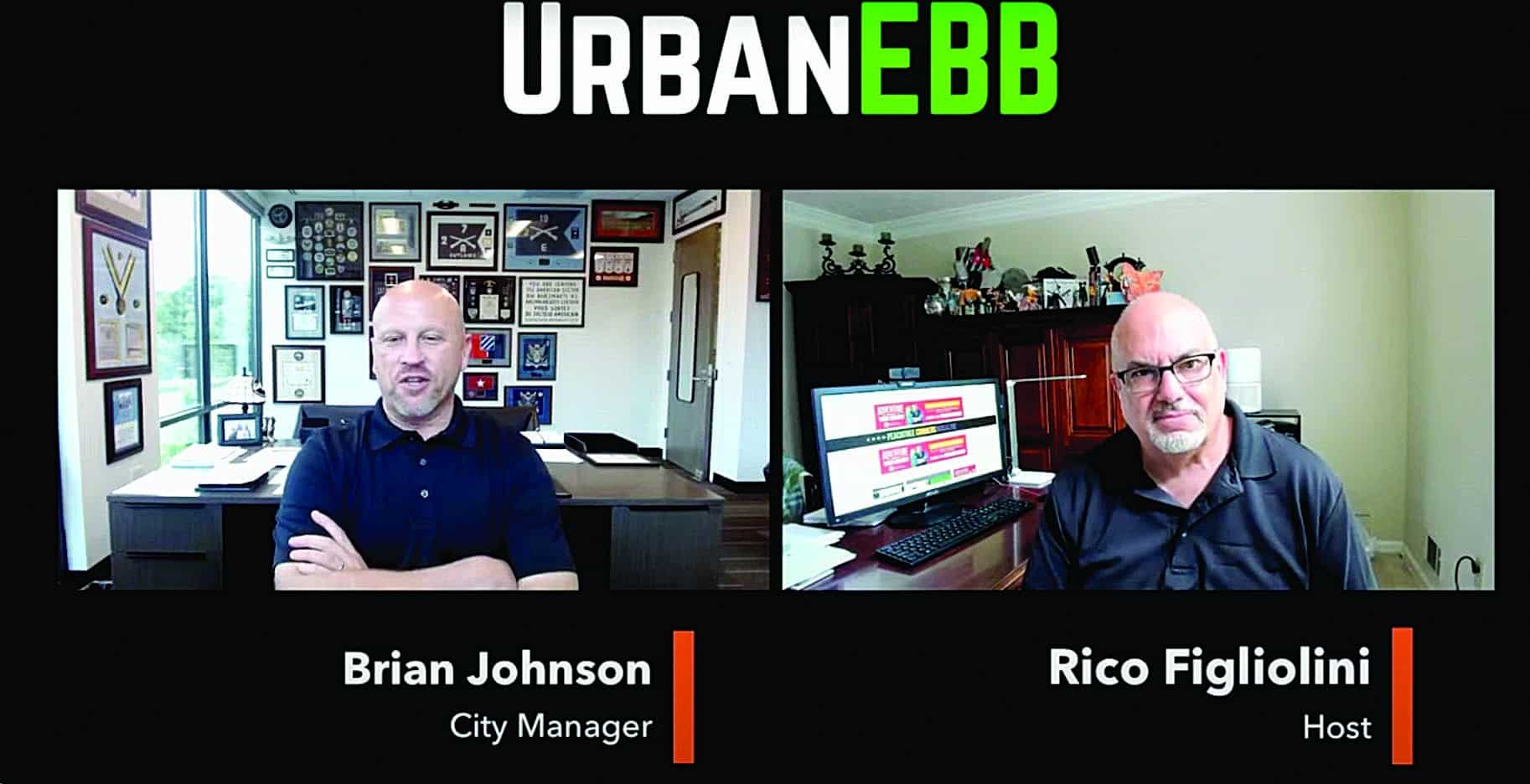
Converting office buildings into apartments is a complex and challenging process, often met with a low success rate due to the inherent design of office structures. Warehouses, on the other hand, offer a simpler conversion path. In this episode, Brian Johnson delves into the intricacies of these transformations and explores what it takes to establish a new city within a metropolitan area, especially when residents feel their taxes are being misused or siphoned off by the county. The discussion provides insights into the complexities and considerations involved in the process of cityhood. Hosted by Rico Figliolini
“Cities have to find ways to generate revenue without always going back to the well of property taxes. If we want to be a community that attracts people, we have to be innovative in how we fund our services.”
Brian Johnson
Timestamp:
00:00:00 – Peachtree Corners’ Office-to-Apartment Conversion Myth
00:03:00 – Adaptive Reuse of Mixed-Use Development
00:05:31 – Repurposing Warehouses and Offices into Lofts and Townhomes
00:08:19 – Impressive Growth and Safety in Suburban Location
00:09:44 – The Evolution of a New City: Challenges and Opportunities
00:13:25 – Transitioning from Unincorporated County to Incorporated City
00:15:57 – Exploring Municipal Funding Strategies
00:17:33 – The Rise of Local Control Through City Creation
00:22:30 – Considerations for Becoming an Independent City
00:24:56 – Considerations for Cityhood Movements
00:27:10 – Navigating City Finances and Service Delivery
00:30:44 – Balancing Municipal Responsibilities and Resources
Podcast Transcript
Rico Figliolini 0:00:26
Hi, everyone. This is Rico Figliolini with Brian Johnson, city manager at Peachtree Corners in the state of Georgia. Hey, Brian, thanks for being with us. This normally would be Prime Lunchtime with the City Manager, but I’ve decided this episode will be part of UrbanEbb, a brand new podcast I’ve been doing with several different people from several different cities, talking also about culture, politics, planning, development. And we’re going to be talking in this episode about city planning becoming a city. How does an area decide they want to be a city? But before we get to that, we’re going to talk about Peachtree Corners was like top three or number one leading a specific area nationwide. And that was about office conversion to apartments. And Brian brought me some real facts about this. So, Brian, why don’t you tell us how this erroneous article stated it and what the real facts are?
Brian Johnson 0:01:27
Well, you know, especially when you’re in a position like me as a city manager of a city, you know, anytime the city that you’re managing is in the news, you always hold your breath, especially when you know why. You know, if my communication director was doing something and I had directed it, and, you know, everybody knew why. But I get the Atlanta business Chronicle email, which has all the titles of some of the stories in there. I see Peachtree Corners in the title, and the title is Peachtree Corners leads us in office to apartment conversions. I’m like, what? So I read it and it said that we had converted a conversion of 295 apartment units going into an office. An office being converted to 295 apartment units led the nation in that conversion. And like you and I talked earlier, the first thing is, you know, 295 leads the United States of America. I found that to be a little bit low. But what was even more telling is the fact that we have never had an office to apartment. I like, we don’t really lead the country in office to apartment conversion, since we’ve never had one. So, you know, the Atlanta business Chronicle is going to run a corrected story. The data that they wrote, the article was not from them, and they did not say it was. It’s from a company called Rent Cafe. And there’s a number of companies that they do open records requests on all rezonings. They take data and they put it in databases. And then they sell the data and cafe erroneously took, we believe. I don’t know for sure, but we know that they based this off of the mixed use development that’s on Peachtree Parkway called Broadstone. And it is about a ten acre mixed use development that has about 25 for sale townhomes, 295 apartment units, and then a. An existing office building that was essentially cut in half vertically. Half of it, all the floors and roof were removed. They let, they kept the exoskeleton of that half of the building. And that provides kind of a, an environment for the community pool and pool deck and everything. And then the other half was renovated. But it’s their, their workout room for the mixed use there and co working space.
Rico Figliolini 0:04:25
Correct. Second story is the co working space there.
Brian Johnson 0:04:28
Right. And so we believe that this rent cafe took some narrative, probably from our staff report, in which we were talking about adaptive reuse of an existing office building, which this. It was.
Rico Figliolini 0:04:45
Yeah.
Brian Johnson 0:04:45
But they assumed that the adaptive reuse was to apartments. And then they pulled the 295, which is the number of apartment units that are on the site, and made the assumption that that conversion happened. So it didn’t. We’ve never had it. Conversion. Conversions are hard. We have discussed trying to convert some to equity. And what generally we get back is if you build an office building, it’s designed to provide building amenities that tend to be more wide ranging and more centralized, like h-vac units are not individually set up. It’s kind of for like, the whole space as a whole. One of the biggest costs are bathrooms. You don’t have plumbing at varying increments. They put all the plumbing in one big community bathroom area. So for then you to go back out and have to cut it up and add all the plumbing, it just becomes cost prohibitive. And so developers tell us.
Rico Figliolini 0:05:57
Right, it’s easier to convert a warehouse because of the open space and stuff into living lofts and stuff like that, or demo it.
Brian Johnson 0:06:07
So the one we have on Engineering drive that the wig owned that they just proved 75 townhomes, an existing office, but it was demoed to build townhomes because it was cheaper than to go into the building and try to cut it up into. So a new.
Rico Figliolini 0:06:29
And even the repurposing of that office behind Broadstone, they thought they’d be able to repurpose that whole building. Right. But once they started demoing, I think the fact is that they found half the building couldn’t be used or something.
Brian Johnson 0:06:42
So they, structural elements of it had been originally constructed using poured concrete and not steel, and they didn’t wrap it and moisture got in. And so part of the building ended up having, you know, it was structurally unsound. And so, yeah, I mean, they did a great job with what they did to make exoskeleton around their pool and put in pool.
Rico Figliolini 0:07:13
Yeah, love that idea. They actually kept that, the metal girders overlapping there like that. So it’s kind of cool to be able to do that. You don’t see that type of stuff here normally. You might see that in, like, buckhead or Brookhaven. They have older buildings there. Out here, it’s much newer, so you don’t get to see that type of use. Right. That normally would be a structural thing that would design as that look, you know, and I found that also Broadstone apartments, 290 odd apartments. They are actually three months ahead of schedule in renting. I think they’re almost at like 82% capacity right now in rentals there.
Brian Johnson 0:07:52
I’ll go one step farther. Alliance and that developer, and they’re an international housing developer. They are. They’re represented by legal counsel, who is representing upcoming mixed use development for. At the city around the building.
Rico Figliolini 0:08:16
Okay.
Brian Johnson 0:08:18
At the planning commission meeting, you know, apartments and all this stuff came up, and the legal counsel said that alliance just announced that Broadstone, this is an international company now, leased up faster than any other property they have ever had in their, in their history, really.
Rico Figliolini 0:08:38
I mean, when I heard that it was three months ahead of goal, I was like. And that maybe. And they just opened some months ago has been a long time. The rents are pretty, you know, I mean, high also. So I’m just.
Brian Johnson 0:08:55
Yeah, they can be.
Rico Figliolini 0:08:56
I think one of the people I spoke to there had told me that it’s just. It’s a great place to be placed because it’s 20 minutes into the city, practically, depending on when you go. It’s 2030 minutes in to midtown, maybe. And you have to deal with the crime down there, living down there. Just come up here and they feel safer, way safer up here than they do if had they lived down, let’s say, Brookhaven or Buckhead area stuff. Plus the rent’s not as expensive as down there. The amenities, pretty good. So. Yeah, so it’s. I’m sure they’re doing a great job. So if they’re going to be doing that day building. How’d that go? That was a first read on that.
Brian Johnson 0:09:36
Well, it’s planning commission. First read. First read was this last Tuesday. So next month be considered by council.
Rico Figliolini 0:09:46
So this is going to be a short episode of UrbanEbb. Actually our normal episode, if you will, 30 minutes. But we wanted to get into cityhood a little bit. Right. City of Peachtree Corners has been around. How long have we been around now? Twelve years. Yeah, about that. And we started out as when it first got voted, and the first rendition of it, if you will, was that we were only going to have three services and we were going to be a light city. Right. Years pass, a couple of things happened. Obviously, there’s no such thing as a light city. Apparently it’s unconstitutional. Every city is the same in the state of Georgia, so we all are able to be full cities if we want to or just retain certain things like police services being coming from Gwinnett county. And thank God Gwinnett county has agreed to provide that type of relationship with us so we don’t have to do our own police service. The reason we’re talking about city stuff is that the city of Mulberry on May 21 was actually voted now into cityhood. So they will be the second largest city in Gwinnett county.
Brian Johnson 0:10:59
The largest by landmass. They’ll have like 2 sq. Mi. More landmass than we will, but different makeup.
Rico Figliolini 0:11:07
Right, because they’re before the show. Yeah, we were discussing that there. I don’t know if these numbers accurate, but 98, let’s call nine in the nineties percentile of only residential homes. So that’s.
Brian Johnson 0:11:22
And that’s a big. Because we derive 22% of our general fund budget comes from our business license. Revenue come from the interact. Well, come from basically our local economy. The company here having to get a business license based on gross receipts of what they generate within our city limits, that’s a good chance. A decent chunk of change on an operating budget like what you use to run on. And with a city that is in the high 90% residential only, they’re not going to really have occupational tax, you know, to speak of, because there’s not many businesses if they’re that high. So that’s a decent chunk of change that they won’t have access to at all.
Rico Figliolini 0:12:20
So that also means, we were talking before about franchise taxes with utilities, that some of that money will be coming back to them. They don’t want to do a property tax, apparently. Correct.
Brian Johnson 0:12:33
It’s in charter that they shall have a zero millage rate unless a referendum is held to that. A successful referendum is held to authorize the city council to levy a millage. But, yeah, that’s certainly the goal for.
Rico Figliolini 0:12:52
You to put it in a chart does the city. But the city can change that charter anytime they want by simple majority vote.
Brian Johnson 0:13:02
That’s correct. Most people, even though cities and counties are what are called subdivisions of the state. So we only exist because the state decided to let cities and counties exist. And when we are created and our city limits are drawn, we, you know, we kind of have, upon becoming a city, certain immediate rights or powers that nobody else, you know, can. Can mess with. We are like the determiner of our destiny at that point. So before we were sitting in Peachtree Corners, the county maintained all the roads that weren’t the two state routes here. County provided place. It was unincorporated county. As soon as we became a city, immediately, the county had no right to do anything without our permission. They had to stop collecting hotel motel tax because those are now our hotels motels. There’s no such a thing as a county road in the context of, oh, that is ours, you know, in perpetuity. The county voluntarily, thankfully, decided that certain roads were so expensive or not expensive, important as kind of a feeder system of the greater county, that they voluntarily said, we’ll continue to maintain those roads. We were like. But beyond that, everything on future decisions are the express and final decision of the duly elected city council. And the state doesn’t have the right, once city’s created, to change laws that only affect one city. When the state does a law, it has to affect all cities or none. And so the charter is another one where putting in a prohibition against a property tax, you can have that language in the original legislation creating the city, and it can be the first language in the charter once the city council is seated. Yes, the first order of business could be a motion in a second to remove that statement from the charter, and that city council could immediately amend the charter and remove it. Now, obviously, there will be political consequences, as you know, for sure. But, yeah, there is no prohibition. Having it in the charter is not a, you know, sacrosanct step where, oh, you have to, you know, Jesus has to miracle it because, I mean, it has to be.
Rico Figliolini 0:15:56
You’re right, there are political consequences. Right. So if the majority of seven council people decided to change that. Yes, they would. Right. But, you know, good intent. Right. There’s good intent to some of these things. Right. They don’t want a millage. Right. Right. That’s how they ran. And that’s how, you know, if a city could do that, that’s how. That would be the best way to do it. Right. This way, citizens don’t have to pay a tax and let the businesses, the for profits, pay those taxes. Right. But if they’re responsible and they realize a year or two or three into it that, well, they can’t make it this way, they need to adjust. Or I guess the other thing could be annexing. If there’s unincorporated areas next to you, and you say, well, heck, that’s a big mall over there, and it’s in the unincorporated. Maybe we can annex that piece of property, because that’s right next door to us. And now they have business taxes. Right. And occupational taxes. That’s one way of doing that. Right. And the other way could be, I mean, most of that area is single family residential, I believe. But let’s say it was apartments. And, you know, going back to that, first thing we talked about, could be conversions, could be, you know, becomes a multi use where maybe there’s more density placed. There could have been one of those garden apartments where there were only 150 units. Now it becomes 300 units and a multi multi use.
Brian Johnson 0:17:28
Well, there’s the problem with that. Rico, what you said is accurate. That is a way to do it. In the case of Mulberry, the impetus for this cityhood movement was essentially anti growth.
Rico Figliolini 0:17:43
Yes.
Brian Johnson 0:17:45
Apartments. And that was the rallying cry for local control. And, you know, which does improve when a city is created. It isn’t the end all, be all, because there are still legal rights property owners have. So city council here certainly has a better grasp of situations that they vote on from a land use standpoint than the Gwinnett County Commission would, especially now we don’t even have one commissioner that lives in Peachtree Corners. Lynette Howard did live here when she was on the county commission. So, you know, in some cases, these commissioners wouldn’t even know anything about what’s happening, you know, down here. But even though council may know the issues better, you know, they can’t just indiscriminately deny things just because they don’t like it without there being legal repercussions.
Rico Figliolini 0:18:41
Correct.
Brian Johnson 0:18:41
And so. But it does improve local control because the council collected officials tend to be a little bit more responsive when they’re seeing their constituents at the grocery store every day and, you know, at the gas station and at the gym. You know, when you’re a county commissioner representing 250,000 people, the odds of you running into somebody, you know, that really, you know, that might campaign against you or something like that, you know, if you don’t do whatever is much lower, I get why they’re. That’s going to be difficult if they run out of money for them to just be like, oh, we’re not going to raise any rates or taxes or whatever. It’s a tough, you know, we don’t have a prohibition against having property tax, but council’s commitment to the residents is that they will do everything in their power not to have city property tax. And so we operate, my staff and I operate the city accordingly.
Rico Figliolini 0:19:46
Yeah, I mean, the only reason apparently to. We had discussed this over the years, I think, about having property tax would be if we were, like you said, operating in the red, or we needed to do things where we needed a large amount of capital and we need to get through an authority or through a bond. However, we would set it up that most financing places would not issue bonds to, let’s say, do major improve capital improvements unless there’s a millage rate in place. Right. I think we had.
Brian Johnson 0:20:25
You know, the bond community is like, all right, I loan you a bunch of money and if things get tight at the city, we don’t want you to make the decision that, you know what, we’re just going to default on that bond payment so that we can meet budget, you know, operating expenses elsewhere. So like general obligation bonds, true, general obligation bonds, where the community votes on it, bond actually have mechanisms in there that if the city could not afford the bond payment, it would compelled to levy a millage to increase our revenue to the point where it could. That’s the whole full faith and credit of the city behind the bond. You can privately place bonds with just the bank without having that component. But the transition starts to get into dollars. You know, we’ve floated when that we didn’t float about, we privately placed a $10 million bond that within our ability to pay it out of pocket every year. You get some of these, like, I know, Marietta, what was it, Franklin street that they did the big. And they floated like a $200 million bond or maybe even higher it went just sweeping through and bought up all the dilapidated stuff and then just redeveloped the whole corridor. You’re going to have to get, you know, that’s where the voters. A lot of market polls because.
Rico Figliolini 0:22:03
So I guess that’s one of the things that we would talk about trends and stuff. Back. Back in the early twenties, there weren’t a lot of these movement towards cities in these becoming new cities. But as over the past decade or so, there’s been a lot of movement towards creating your own city, especially up here in northern, above north Atlanta, you had the city of Milton, you had John’s Creek, you had a bunch of these. I think Tucker may be the next one. Or, I mean, there’s a bunch of these that have one Brook cave. Brookhaven. That’s right. City of Brookhaven. Right. So, I mean, they’re all trying to get away from county control or from supposedly monies going to other parts of the county where they felt they’re not getting enough bang for their buck. So a lot of money is coming out of one place and maybe being drawn and used in other places. So there’s that trend for being a city. So in our limited time here, what would be the three things that you, Brian Johnson, city manager and having gone through this and have been a city manager in other cities across this country, southeast, what would you recommend people should look at before they go stepping into this? What are the three things or maybe more or less that they should think about?
Brian Johnson 0:23:25
Well, you know, first is there’s a lot of unknowns that you still world of unknowns that you step into when you become a city. You know, it’s almost a little bit like growing up. You know, kids at a certain point, they’ve got this level of independence and they’re kind of thing at the rules of mom and dad. And, you know, you start getting to this, well, I’m going to go out on my own so I can make all my own decisions and I don’t have to live. But when they do step out and all of a sudden, all of these responsibilities are theirs, mom and dad aren’t the safety net to remind them to pay that bill or to do whatever.
Rico Figliolini 0:24:12
Great analysis.
Brian Johnson 0:24:14
How many can get? Like, whoa, I didn’t realize that there was all this work, you know, this and that, and a little bit like that with cities. So I would first start and say, I think there needs to be good motivation to do that. You mentioned a few of them. Most of the Fulton, north Fulton county cities were motivated because property tax revenue the county was charging was basically being collected from the northern area. And then the redistribution of wealth argument that drove a lot of Sandy Springs and Johns Creek, you know, people to the polls. Some of the Dekalb county cities, you know, Tucker, you know, Brookhaven tended to be Dekalb county government is so inept and corrupt that we just don’t want to depend on them for stuff. So let’s just go ahead and do it. Then you probably say, you know, there’s a few exceptions. You know, the Gwinnett, you know, Peachtree Corners was a little bit of this. The Sharon Springs attempt up in Forsyth, certainly the Mulberry generally a little bit about land use decisions. They were kind of like, felt like the county commission of Gwinnett representing such a law. They have five commissioners for basically a million people, so each commissioner presenting 250,000. And there are examples where it’s hard for you to intimately get up to speed on everything that you’re being asked to vote on. And Peachtree Corners want a little bit more local control over certain things. Certainly Mulberry as well. And then the last example is yet two examples, eagles Landing and Buckhead, which were attempted cityhood movements in which an area of an existing city tried to secede the city. Buckhead is merely a. A named, you know, a generally accepted named area of. City of Atlanta. It is city of Atlanta. And, you know, for them to become a city would have actually required them to secede from the city of Atlanta. I mean, just a bizarre and I think, dangerous precedent. So, anyway, I would say make sure motivated for the right reasons, because there have been examples I have been asked to consult with that they didn’t necessarily do it for the right reasons. And as a result, you know, there was really not the interest. Once you do that, make sure you know which services you really want to have the control of. You know, if it’s. If, you know, if solid waste collection is a big, controversial thing and you want to have control over who’s going to pick up your trash, then make it something you’re going to do. But, you know, don’t just wait into areas just because you can, you know, like, oh, you can. We can have our own parks and rec department. Well, those departments are black holes for money. They all lose money, you know, so you just got to be careful of what you want to get into. And then the third is make sure that, you know, your eyes are wide open on, you know, in the guess in the area of service delivery, in that there are certainly things in the future. Some could be your own doing or some could be at, you know, the political winds of the community push you that way, and some could be you didn’t have a choice. But there is a risk that you find yourself having no more money and there’s some other expense that drops in your lap or is being pushed on you. And that’s all fine. Cities have lots of ways to generate revenue. But if one of the main tenants of your cityhood is like, you know, no city property taxes, whatever, it’s all great goal, but know that you may find yourself one day not having a choice. That’s the one bad thing with you. Know, almost like the kids leave the house and one day they can’t pay all their bills. They have one or two choices. They can do something to make more money, like get a second job, or they can cut expenses. They could stop, you know, having cable television or a Hulu subscription. Cities can do the same thing. We can decrease the level of service that we do. In some cases, we can stop doing certain things. So, I mean, just, it’s like a household budget, but. But as long as people know, it’s the balance of, you do have local, more control. And, you know, we struggle with this here a little bit with police. We’ve talked about it. We have a good arrangement, but we do not control police as directly as we would and could if it was our police department. We sometimes run into differences of importance. You know, for us, our town center is extremely important thing, and we’ve generated a lot. We’ve created a lot of activity out there, for sure. We would probably push more police presence in that area preemptively than Gwinnett does. Gwinnett tends to be like, look, that is not a priority for us, and we don’t have the resources to preemptively just have police there will respond if we need to, but we’re not going to. That’s just the difference of both resources and priorities. But that’s what with the new city, and that’s kind of the, that’s the debate.
Rico Figliolini 0:30:13
They tend to be a little bit more reactive, especially not having enough police to be able to cover everything they need to. We’ve come to the end of this. But what I realized, it’s funny, we were brainstorming a little bit before, is that I’d like to do a part two of this a little longer, maybe, and discussing what it means to do services and what the pros and cons are, and politically speaking, a little bit to a degree, because county can say to a city, you know what? We don’t have enough offices as it is. Why don’t you take care of your own police force? Because they can’t say that, right? They don’t have, there’s no rule that says they have to provide it. And they can say, okay, we’re going to redirect the rest of our police force to the unincorporated areas because we could now put more attention to that. You all are your own city, so handle it yourself. So there’s so much more we can talk about.
Brian Johnson 0:31:12
Well, even real quick, Rico, on that one. A big part of ours is we have a lot of mission creep with residents wanting us parks, why doesn’t the city just buy that and turn it into a park? Well, that takes money to buy and it takes money to maintain. And if we turn, if we bought and turned everything, every time we get that into a park, we, you know, run out, we wouldn’t have enough money. So it happens even out of the most innocent.
Rico Figliolini 0:31:40
Yes. You know, and I appreciate that. I do. We get that in business sometimes, especially when I have a retainer clients to think, oh, they can, they can get more out of this. It’s like, no, no, you really paid for this. That’s all you’re going to get, please. But. So we’ll probably do a part two on this, I think. I think to get people to understand more, and not just us, but I think spread that knowledge out to other people, other people planning to maybe possibly doing a city across the country and stuff. So. But I want to thank Brian for being with me today. Thank you. And this is just ahead of Memorial Day weekend, so appreciate you being here with me. And thank you, everyone. Sure. Hang in there for a sec. But thank you, everyone, for being with us.
Related
Read the Digital Edition
Subscribe
Keep Up With Peachtree Corners News
Join our mailing list to receive the latest news and updates from our team.
You have Successfully Subscribed!

From Boardrooms to the Himalayas: Vandana’s Journey to Purpose and Growing with Intention [Podcast]

Guardians of the Jukebox to Play the VoxStage on May 31

Music Matters Productions Expands Peachtree Corners Headquarters

Brandon Branham Honored for Transformative Leadership in Peachtree Corners

“Geek Culture” Shines at 2025 MomoCon

Celebration and Community: ICAGeorgia Wraps Up School Year with Two Festive Events

The PCBA Awards $500 to Light Up The Corners at After-Hours Event

Vox-Pop-Uli Launches RED Initiative for Veterans’ Support

Vox-Pop-Uli Launches RED Initiative for Veterans’ Support

The PCBA Awards $500 to Light Up The Corners at After-Hours Event

“Geek Culture” Shines at 2025 MomoCon

Celebration and Community: ICAGeorgia Wraps Up School Year with Two Festive Events

Guardians of the Jukebox to Play the VoxStage on May 31

Music Matters Productions Expands Peachtree Corners Headquarters

Brandon Branham Honored for Transformative Leadership in Peachtree Corners

From Boardrooms to the Himalayas: Vandana’s Journey to Purpose and Growing with Intention [Podcast]

Light up the Corners [Video]

Capitalist Sage: Business Leadership in Your Community [Podcast]

Cliff Bramble: A Culinary Adventure through Italy

Top 10 Brunch Places in Gwinnett County

A Hunger for Hospitality

THE CORNERS EPISODE 3 – BLAXICAN PART 1

Top 10 Indoor Things To Do This Winter

The ED Hour: What it takes to Remove Barriers from Education








